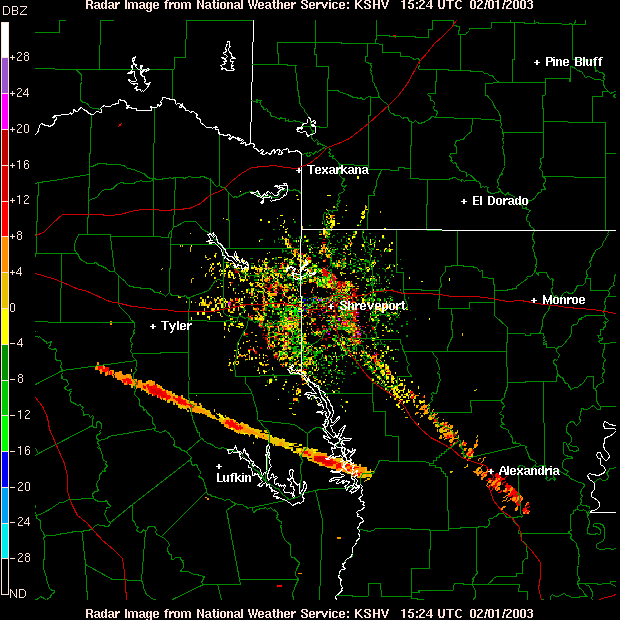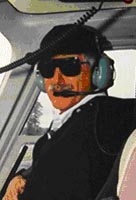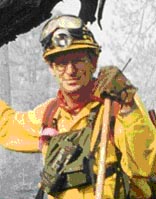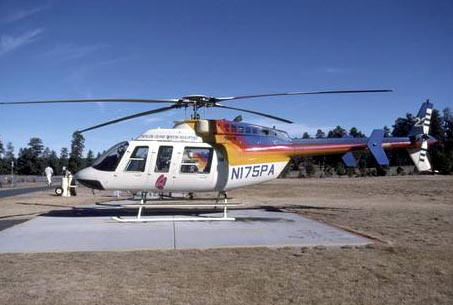 | National Weather Service radar imagery of the reentry trail of "Columbia" over eastern Texas and Louisiana |
A National Tragedy On January 16th, 2003, the space shuttle Columbia launched into orbit, carrying numerous microgravity and science research experiments. Sixteen days after what was then called a textbook launch, and only sixteen short minutes until its arrival at the Kennedy Space Center in Florida, Columbia broke up during re-entry to the Earth’s atmosphere on February 1st, 2003. Debris from the shuttle rained down to the ground from an altitude of 38 miles over the state of Texas. Immediately, a search for the debris commenced. An aerial search aided ground searchers by covering vast areas in less manpower. Pilots and crews from across the nation were called into the effort. The challenge of finding shuttle debris by spending hours at a time in the air searching a 2-mile grid along lines marked 30 feet apart attracted many from far and wide. Answering the Call...  A member of the search effort for fragments of Columbia was Jules Francis “Buzz” Mier. Born in Louisiana, the 56-year-old got his first taste for flying while in Army where, as one of the top graduates of his pilot training class, he was sent to Vietnam, racking up over a thousand combat hours, and earning several medals for merit and heroism under fire. After his tour in Vietnam, “Buzz” served as an advanced instrument flight instructor at Fort Rucker, Alabama, for nearly 20 years, while for 10 years concurrently a member of the Alabama Air National Guard’s 1133rd Medevac Air Ambulance unit. A member of the search effort for fragments of Columbia was Jules Francis “Buzz” Mier. Born in Louisiana, the 56-year-old got his first taste for flying while in Army where, as one of the top graduates of his pilot training class, he was sent to Vietnam, racking up over a thousand combat hours, and earning several medals for merit and heroism under fire. After his tour in Vietnam, “Buzz” served as an advanced instrument flight instructor at Fort Rucker, Alabama, for nearly 20 years, while for 10 years concurrently a member of the Alabama Air National Guard’s 1133rd Medevac Air Ambulance unit.
In the spring of 1996, he joined 'Papillon Grand Canyon Helicopters' of Arizona to fly tourists over the Grand Canyon. He had also flown numerous and diverse contract work flights, from work on power line and commercial film charters, to flying Fish and Game personnel. He had over 8,200 total flight hours in helicopters, with over 150 hours in the Bell 407, and the loss of the Columbia led to him working a contract with the Texas Forest Service to assist in locating and recovery shuttle debris in remote areas of the state’s forest.  Managing the search crew aboard the helicopter was Charles Krenek. Born in Bay City, Texas, in 1954, Krenek was hired in 1977 by the Texas Forest Service and within six years he was promoted to Forest Technician III, the highest technician level in the agency. . Married, and with one son, he set the standard for forest technicians and was recognized as one of his agency’s best ambassadors for working with external agencies and the public, being decorated with the Director's Award for Field Technician in 1984, the Texas Forest Service Director's Award for Team Effort in 1989, and was presented with the service’s Best Maintained Unit Award in 1994. Managing the search crew aboard the helicopter was Charles Krenek. Born in Bay City, Texas, in 1954, Krenek was hired in 1977 by the Texas Forest Service and within six years he was promoted to Forest Technician III, the highest technician level in the agency. . Married, and with one son, he set the standard for forest technicians and was recognized as one of his agency’s best ambassadors for working with external agencies and the public, being decorated with the Director's Award for Field Technician in 1984, the Texas Forest Service Director's Award for Team Effort in 1989, and was presented with the service’s Best Maintained Unit Award in 1994.
Charles was an aviation specialist and assisted in maintaining and operating air tanker retardant plants, helo-bases and support equipment in mitigation and fire-suppression efforts. He served as a wild land firefighter, worked with fire prevention teams and assisted the Texas Forest Service’s incident management team. His 26 years of overall experience would aid greatly in the recovery effort. Flying Low... Nearly two months into the effort, about 1.3 million acres had been searched and more than 900 items were recovered as a result of the air search operations. 
On March 27th, 2003, three others would join the pair in one of Papillon Airways Bell 407 helicopters: Richard Lange, an employee of the United Space Alliance at Kennedy Space Center in Florida, who worked on shuttle pad 39A with the cold oxygen and hydrogen tanks that give the shuttle electricity; Ronnie Dale, also of the Kennedy Space Center, and a 12-year veteran working on quality control for the shuttle program; and Matt Tschacher of the U.S. Forest Service in South Dakota. The helicopter, tail number N175PA, took off shortly after 3:15 PM on that March day, near the Angelina National Forest in San Augustine County, near Broaddus, Texas, on its second search mission of the day, hovering about 125 feet above the ground. Over an hour into the flight, a problem developed. Low to the ground, and nearly brushing the treetops as it was, there was little time to react. William Dickerson of San Augustine, Texas, said he and his nephew were on a fishing trip and saw the helicopter fly overhead. Dickerson said the helicopter suddenly went silent, then crashed into the trees, according to the Houston Chronicle. "When we heard it, we knew what it had to be," he said. "It was just like the motor went dead." Dickerson said the helicopter landed in a swampy area, with the motor buried in the ground and pieces of the chopper strewn around. The cockpit section of the fuselage was found crushed and the main cabin was mostly intact, and the tail rotor blades were damaged, the stinger broken, and the tail rotor gearbox was fractured. From the crash impact, the three in the helicopter's cabin were all injured: Dale had a punctured lung, Lange had shoulder & hip injuries, and Tschacher suffered a spinal injury. But the occupants of the cockpit, Krenek and Mier, were killed instantly in the crash. Dickerson and his nephew helped the three survivors out of the woods and to the side of the road before going to a nearby house to call for help. From there, the three survivors were taken to Memorial Medical Center of East Texas in Lufkin. Solving the Puzzle... Air operations of the effort were suspended for 11 days until it was determined flights could resume under the safest possible conditions. On April 10th, 2003, the aerial searches for debris resumed. After the helicopter wreckage was recovered, the engine, still largely intact and undamaged, was removed and set up in a testing rig. During the test run, it was discovered that the power lever angle (PLA) indicator on the Hydro Mechanical Unit (HMU) responded erratically to normal throttle inputs when the engine was operated in the electromechanical mode. Interestingly. the engine operated normally in the manual mode. Further testing and evaluation of the HMU revealed anomalies with the potentiometer component of the system. The National Transportation Safety Board concluded that the probable cause of the accident was, "the partial loss of engine power due to erratic fuel flow metering to the engine resulting from the single point failure of the Position Lever Angle potentiometer in the hydro-mechanical fuel control unit." Contributing to the crash was the lack of suitable terrain to execute a forced landing. Lasting Effects... The NTSB went even further as a result of the findings from the investigation, and mandated the issue of four safety recommendations (A-03-18 through A-03-21), on May 27, 2003, to the FAA that addressed the PLA potentiometer deficiencies. As a result, no further problems have occurred, worldwide, with the PLA units in Bell 407s. In its final report, issued August 23rd, 2003, the Columbia Accident Investigation Board (CAIB) determined the cause of the Columbia's breakup to have originated 82 seconds after launch, when a large piece of foam insulating material from the external tank broke free and struck the leading edge of the shuttle's left wing, damaging the protective carbon heat shielding panels. This damage allowed super-heated gases to enter the wing structure during re-entry into the earth's atmosphere and caused the destruction of the Columbia. The Board further found that the problem of debris shedding from the external tank was well known and had caused shuttle damage on every prior shuttle flight. The damage was usually, but not always, minor. Over time, management gained confidence that it was an acceptable risk. The CAIB found that this should not have happened. And Tributes... When NASA's Mars Exploration Rover "Spirit" landed on Mars January 3rd, 2004, it brought with it a small commemorative plaque bearing the names of the seven astronauts. Spirit's landing area on Mars will now be known as the Columbia Memorial Station On September 10, 2004, Charles Krenek was awarded the "Star of Texas" Award by Texas Governor Rick Perry, for bravery, courage, and determination in assisting others. In Hemphill, Texas, a 1-ton, 5-foot-tall column is engraved with the names of Columbia's crew: Laurel Clark, Kalpana Chawla, Rick Husband, William "Willie" McCool, Michael Anderson, David Brown and Ilan Ramon, Israel's first astronaut in space. However, also recognized at the site of the Hemphill memorial, were Charles Krenek & "Buzz" Mier. A three-quarter-ton, 2-foot-tall monument, bears their names as well, representative of their sacrifice during the debris search: |
